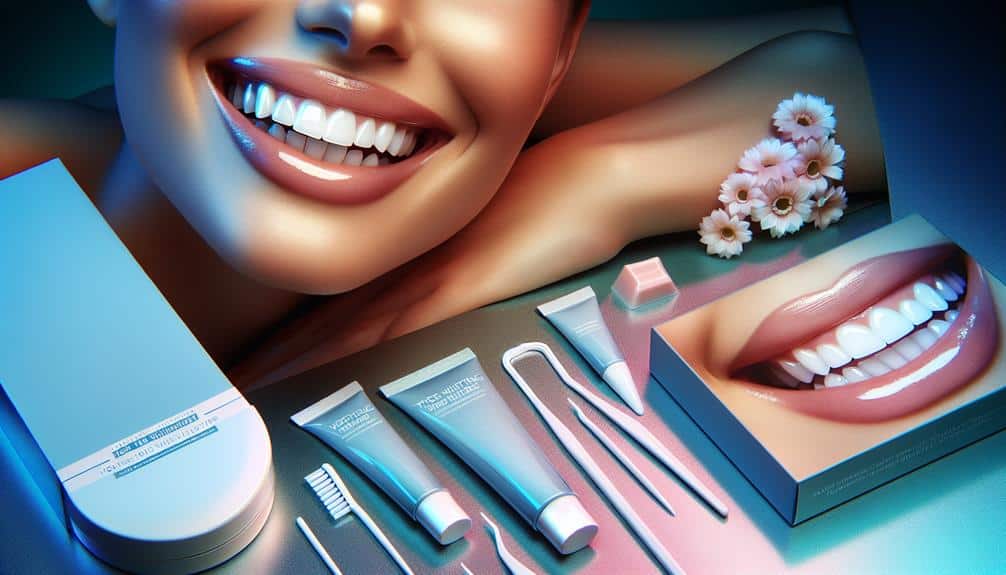When you aim for a brighter smile endorsed by dental professionals, dentists recommend teeth whitening strips for their safe, effective, and convenient method that provides long-lasting results. The strips apply a bleaching agent like hydrogen peroxide to break chemical bonds of surface stains from coffee, tea, or smoking, resulting in a radiant smile. Brands like Crest 3D Whitestrips and Oral-B Whitestrips are dentist-approved options to contemplate, ensuring efficacy and safety with the ADA Seal of Acceptance. Proper application techniques are key for best outcomes, and consulting your dentist before starting a whitening treatment is advisable for the greatest results.
Key Points
- Dentists recommend whitening strips for safe, effective home use.
- Whitening strips offer long-lasting results when used consistently.
- Cost-effective compared to professional treatments, strips are convenient.
- Brands like Crest 3D Whitestrips are dentist-approved for efficacy.
- Proper application and dentist consultation are crucial for best results.
Benefits of Teeth Whitening Strips
Improving the appearance of your smile with teeth whitening strips is a safe and effective way recommended by dentists. One of the key benefits of using teeth whitening strips is their long-term results. When used consistently and as directed, these strips can provide lasting effects, giving you a brighter and more radiant smile. Additionally, teeth whitening strips are a cost-effective solution compared to professional whitening treatments, making them a popular choice for individuals looking to enhance their smile without breaking the bank.
Another advantage of teeth whitening strips is the convenience they offer. You can easily use them in the comfort of your own home, eliminating the need for frequent visits to the dentist's office. This at-home use feature makes teeth whitening strips a practical option for individuals with busy schedules or those looking for a hassle-free way to whiten their teeth. Overall, the combination of long-term results, cost-effectiveness, and convenience makes teeth whitening strips a compelling choice for achieving a brighter smile.
How Whitening Strips Work
Teeth whitening strips work by applying a bleaching agent to the surface of your teeth, targeting and removing stains to reveal a brighter smile. The bleaching agent, typically hydrogen peroxide or carbamide peroxide, penetrates the enamel to break apart the chemical bonds that create stains. This process is effective in removing surface stains caused by coffee, tea, or smoking.
The effectiveness of whitening strips varies depending on the concentration of the bleaching agent and the duration they're worn. Following proper application techniques is vital for achieving best results. Make sure your teeth are clean and dry before applying the strips, and avoid getting the gel on your gums to prevent irritation.
It's important to wear the strips for the recommended amount of time per day and to complete the full treatment course for the best outcome. By following these application techniques, you can maximize the effectiveness of whitening strips and achieve a whiter, brighter smile.
Dentist-Approved Whitening Strip Brands
Among the various brands of teeth whitening strips available, some are specifically recommended by dentists for their efficacy and safety. When seeking dentist advice on whitening strip brands, consider those with the American Dental Association (ADA) Seal of Acceptance. This seal indicates that the product has met the ADA's criteria for safety and effectiveness. Dentists often recommend well-known brands such as Crest 3D Whitestrips, Oral-B Whitestrips, and Opalescence Whitening Strips due to their proven track record in providing noticeable results while being gentle on the teeth and gums.
Product recommendations from dentists also consider factors like the concentration of the whitening agent, ease of use, and potential side effects. Dentist-approved whitening strip brands usually have clear usage instructions and proper concentrations of whitening ingredients to ensure the best results without causing harm to the teeth. Remember to consult your dentist before starting any whitening treatment to make sure it's suitable for your oral health needs.
Tips for Using Whitening Strips
When using whitening strips, make sure to carefully follow the instructions provided by the manufacturer to achieve the best results while maintaining oral health. To guarantee the effectiveness of the whitening process, here are some tips and best practices to take into account:
- Consistency: Use the whitening strips consistently as recommended by the manufacturer. Skipping treatments can hinder the desired results.
- Avoid Overuse: Don't exceed the recommended usage time. Overuse can lead to tooth sensitivity and gum irritation.
- Preparation: Before applying the strips, make certain your teeth are clean and dry. Plaque or debris can interfere with the whitening agent.
- Application Technique: Place the strips carefully, ensuring they cover the teeth evenly and securely. Avoid contact with the gums to prevent irritation.
- Post-Treatment Care: After removing the strips, brush your teeth to remove any remaining gel and rinse your mouth thoroughly.
Potential Side Effects to Consider
Take into account potential side effects that may arise from using teeth whitening strips to guarantee a safe and effective whitening experience. Sensitivity management is an important aspect to keep in mind when using these strips. Some individuals may experience increased tooth sensitivity during or after the whitening process. This sensitivity is usually temporary and can be managed by using toothpaste designed for sensitive teeth or by reducing the frequency of whitening strip use.
Additionally, it's essential to contemplate the long-term results of using teeth whitening strips. While these strips can effectively whiten teeth, overuse or improper use can lead to enamel damage or gum irritation. To mitigate these risks, it's recommended to follow the instructions provided with the whitening strips carefully and not exceed the recommended usage frequency. Seeking advice from a dentist before starting a whitening regimen can also help prevent potential long-term issues and ensure a successful whitening outcome.
Frequently Asked Questions
Are There Any Long-Term Effects of Using Teeth Whitening Strips?
Using teeth whitening strips may have potential risks like tooth sensitivity or gum irritation. However, the long-term benefits can include a brighter smile. Consult your dentist for guidance on how to safely achieve and maintain whiter teeth.
Can Teeth Whitening Strips Damage Dental Work Such as Crowns or Veneers?
Using teeth whitening strips can potentially damage dental work like crowns or veneers. It's important to consult your dentist before use. Alternative options such as professional whitening treatments tailored to your dental work may be safer.
What Is the Recommended Frequency for Using Teeth Whitening Strips?
For best results, use teeth whitening strips as directed by your dentist. Following suggested whitening frequency can enhance benefits and provide noticeable results. Tips like avoiding staining foods can help maintain your brighter smile longer.
Can Teeth Whitening Strips Help With Deep Stains or Discoloration?
Teeth whitening strips can help with deep stains or discoloration. They are effective for surface-level issues. For more stubborn discoloration, professional whitening treatments are recommended. DIY remedies have limitations and safety concerns, so consult a dentist for best results.
Are There Any Natural Alternatives to Teeth Whitening Strips That Dentists Recommend?
Looking for natural alternatives to teeth whitening strips that dentists recommend? DIY options like baking soda and hydrogen peroxide can be effective. Remember to consult your dentist for guidance on safety and precautions.



